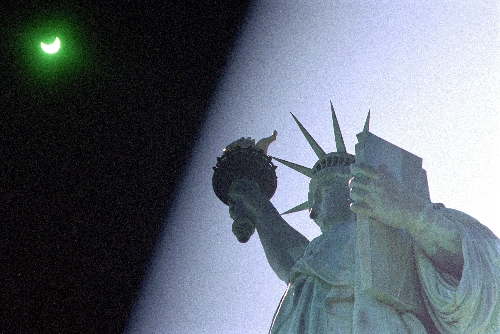CSN Planetarium plans viewing party for solar eclipse expected Sunday

It won’t be a total eclipse, but star gazers say it will be something to see.
An annular solar eclipse, when the moon passes between the Earth and the sun, thus obscuring the image of the sun to an Earth viewer, is expected between 3 p.m. and sunset Sunday.
The moon is too small to cover the sun, which causes a ring of sunlight in an annular solar eclipse.
Though it will be visible in Southern Nevada, it will be a perfect ring only in northeast areas and into southeast Utah, said Dale Etheridge, director of the College of Southern Nevada Planetarium.
Parts of the area just aren’t hit by the right shade, he said.
"The path of the moon shadow is 250-300 miles wide, and for 1,000 miles on each side of it, you’ll see a partial eclipse," Etheridge said. "From here, it’s going to be 96 or 97 percent coverage."
The planetarium, at CSN’s Cheyenne campus, 3200 E. Cheyenne Ave., welcomes the public for a viewing party at 3 p.m. during the eclipse.
Telescopes are to be provided, and protective eyewear will be available for sale.
Filtered glasses are recommended for viewing, as the naked eye could be damaged by the sunlight peeking around the edges of the moon.
The glasses are for sale in the planetarium in the days leading up to the eclipse for those viewing at home, Etheridge said.
He also encouraged people to mark their calendars for June 5, when a transit of Venus is expected. The planet passes directly between the sun and Earth and can be seen as a small black disk against the bright background of the sun.
The sighting occurs two times in succession every 125 years, Etheridge said. The most recent transit was about 12 years ago.
"This will be our last chance to see it in anyone’s lifetime," he said.
Observations of an annular solar eclipse are a bit more regular, said Jim Gianoulakis, president of the Las Vegas Astronomical Society, a nonprofit organization of amateur astronomers.
They occur about 18 years apart. The last eclipse of its kind was May 10, 1994.
"It’s a relatively rare event," Gianoulakis said, "but easy to observe."
Gianoulakis and the Las Vegas Astronomical Society plan to view the eclipse from Cathedral Gorge State Park near Panaca.
"In Las Vegas, you’re not going to get the effect of the diamond ring-type thing," he said. "An eclipse has a fairly narrow path of totality."
For more information, call 651-4759, visit csn.edu/planetarium or email planetarium@csn.edu.
Contact Centennial and North Las Vegas View reporter Maggie Lillis at mlillis@viewnews.com or 477-3839.